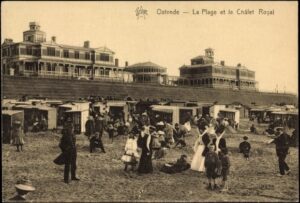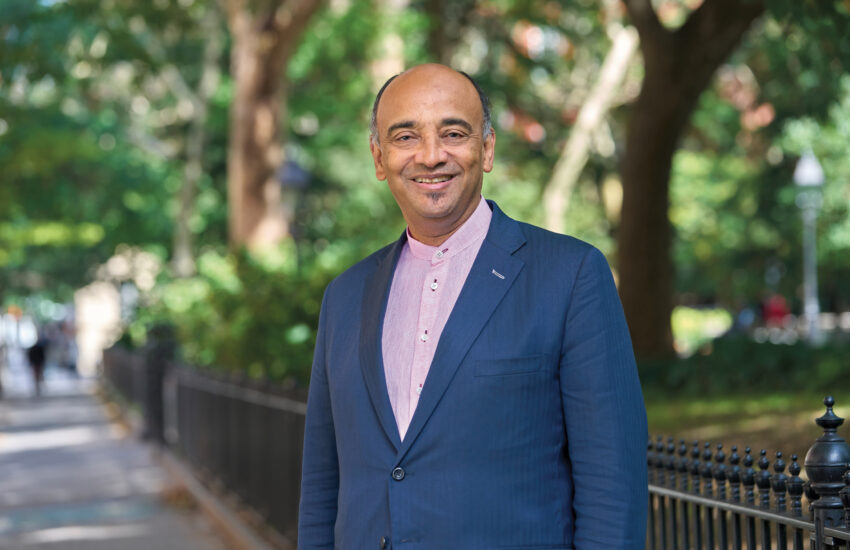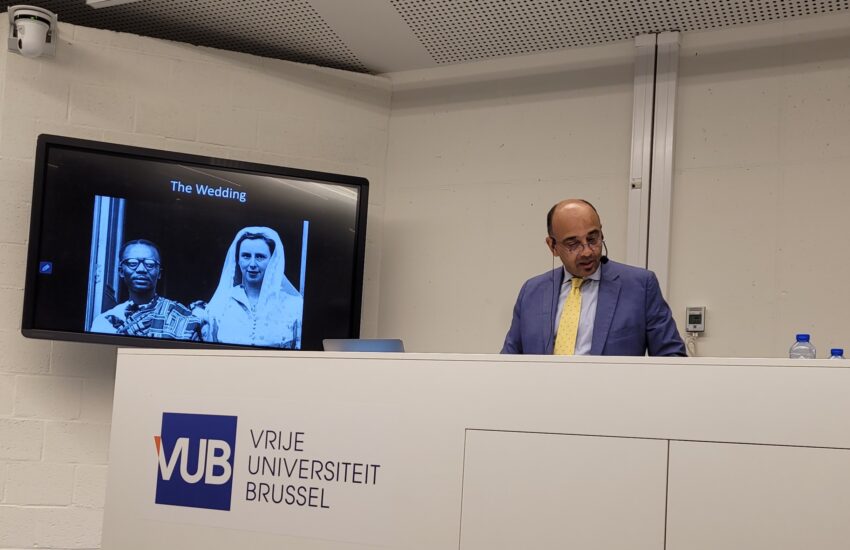King Leopold’s Coastal Vanity Project: Reflections on a Decolonised Guided Tour of Ostende
 I disembark at Ostende station (left) one sunny but fresh Sunday morning in late Spring. The Belgian coastal city has been a source of fascination since Afropean’s own Johny Pitts recommended the documentary filmed here during the last days of Marvin Gaye’s life. The tragic soul man escaped to Ostende whilst trying to wean himself off substances.
I disembark at Ostende station (left) one sunny but fresh Sunday morning in late Spring. The Belgian coastal city has been a source of fascination since Afropean’s own Johny Pitts recommended the documentary filmed here during the last days of Marvin Gaye’s life. The tragic soul man escaped to Ostende whilst trying to wean himself off substances.
Yet despite my interest, in the almost three years since moving to Belgium, this will only be my second time in the seaside town. Both visits have had some political connection. The first was during an intemperate weekend in September 2022, for the international Manifiesta festival. Today, I return for an historical tour of the city through a decolonised lens. The trip has been organised by Intal; an anti-colonial, internationalist peace initiative based in Belgium with partners throughout the Global South. I’ve recently become a member.
These alternative history tours are fairly commonplace in Brussels, where I currently live. The organisers at Intal want to redress the imbalance. I myself am used to doing regular old city tours in countries with heavy imperial baggage. More than once, I have felt frustrated by the scant reference to their colonial past.
The Ostende tour is guided by one Michael Meeuwis; a professor in the department of African Languages and Cultures at Ghent University. Flemish Meeuwis has stayed in the DRC several times; enough to have become proficient in Lingala. He also has an excellent command of French, in which the tour is conducted. Nevertheless, given this is a de-colonial tour, I wonder out loud during an earlier Intal meeting if nobody indigenous to one of Belgium’s former colonies could have led it. I am informed that only Meeuwis has the availability and expertise on Ostende. This says as much as anything about how academia is yet to reckon with its own colonial overhang.

A vintage view of what was once the Royal Chalet, Ostende
The tour begins at Ostende train station, where Michael recounts the infamous King Leopold II’s ambitions for the old fishing town. His parents, Leopold I and Louise-Marie, whiled away their summers near the sea. Leo Jr wanted to turn the once sleepy bayside village into a coastal city to rival Brighton, Nice and Monaco. He poured the blood money procured from his brutal exploits in the Congo into the town’s infrastructure. Buildings all over Ostende bear the double-L insignia of two generations of Leopolds. Aspects of the cityscape are ‘L’- shaped by design, such was the magnitude of the younger Leopold’s conceit.
Early on in the visit, Prof. Meeuwis highlights the Belgian monarchy’s blood links to that of the UK. Leopold II and Queen Victoria were cousins. Empire was a family business.
In the vicinity of the oft-renovated Ostende casino, running parallel to Marie-José Square, is Leopold II Avenue. Michael mentions that campaigns to have the street renamed in honour of the slain first leader of an independent Congo, Patrice Lumumba, have so far fallen on deaf ears.
Prof. Meeuwis lingers near the bust of Auguste Beernaert; erstwhile Belgian prime minister and Nobel Peace Prize laureate. Beernaert had a turbulent relationship with Leopold II. The two men were initially confidantes, Beernaert believing that the King’s plans in Africa were of a philanthropic, liberating and ‘civilising’ nature (and so many other colonial clichés). Auguste swiftly became disillusioned when the extent of the horrors in the Congo came to light. He went from being the King’s close friend to one of his fiercest critics. During his time as Belgian premier, Auguste attempted to mitigate some of the violations by officially recognising the Congoleses’ human rights in parliament. It was a mere sticking plaster, admits Prof. Meeuwis, but it reveals how much Beernaert had turned against his one-time ally.
Auguste is also credited with laying the foundation for what would become the International Court of Justice at the Hague, Netherlands. Our tour guide rues that Beernaert remains somewhat an underrated historical figure.
The group moves nearer the bay. Close to the beach is Paris Road (Rue de Paris). Now a nondescript street obscured by road works, it was once the haunt of Leopold II’s private bankers. There are no exact figures for the fortune Leopold II amassed from his exploitation of the Congo. Modern estimates suggest it would be worth at least several hundred millions of euros today.
A stone’s throw away from Rue de Paris stands the King’s old chalet, which included an underground passageway connecting him to his mistress’ lair, also in the neighbourhood.
We pass by what was the Royal Villa. Michael draws our attention to the astral motif that adorns the gates, as well as other former colonial buildings we’ve seen en route. He points out that stars also feature on the present day Congolese flag. The idea is said to have come from Henry Morton Stanley, Leopold II’s man on the ground (The King himself never set foot in Congo). Stanley in turn is said to have been inspired by the Texan flag, during his time as a confederate soldier in the American Civil War. For Prof. Meeuwis, it’s incongruous that this colonial symbol is still part of the Congolese flag.
It was at this Royal Villa that the first map of the Belgian Congo was said to have been drafted. It’s also where dignitaries were welcomed to discuss the apparent scourge of the Arab slave traders in the West and Central Africa region. This formed part of Leopold II’s elaborate PR campaign to justify his incursion into Congo to the Belgian public.
Prof. Meeuwis leads us to the largest statue in Ostende dedicated to the king for whom the term ‘crimes against humanity’ found one of its earliest uses. The now-discoloured bronze edifice shows Leopold II mounted triumphantly on a steed. To his left are fawning members of Ostende’s fishing community, offering up their children to the monarch. The tableau is mirrored on his right. This time the grateful supplicants are Congolese, overseen by a stern colonial official. Observing this scene is a woman in a long flowing robe – representing Belgium itself- with a flame in her right hand, also gesturing towards the mounted king. The sculpture was created in the 1920s/early 30s – decades after Leopold’s death. For our guide, this exemplifies the cult of Leopold II; a type of deification of the depraved sovereign.
In 2004, a group of Ostende-based anarchists insisted that the sculpture more accurately reflect what really went on in Congo during Leopold II’s reign. The group eventually decided to effect the change themselves. The authorities acquiesced. A Congolese statue is now missing a limb, to represent one of the most notorious acts of butchery by Leopold’s colonial forces. This small but significant change is indicated in Dutch on a modest, easy-to-miss plaque.
The Ostende decolonisation movement scored a greater victory elsewhere. Five to ten minutes away by foot, lies a park where a bust of the King proudly stood. It was removed in the wake of the 2020 global anti-racism uprisings. According to Michael, the local authorities – a conservative coalition of the centre-right Flemish Liberal Party and the Christian Democrats – have grown even more recalcitrant about any further decolonisation of public spaces. The professor adds that there are many amongst the political class with historical colonial connections.
We end the tour back at the ignominious monument in memory of Leopold II. We have returned to observe a minute’s silence for the victims of the King’s barbaric regime. We gather solemnly around the Congolese figures, to give honour to whom it should be due.
A version of this article also appears on the La Vie Continentale blog




As a resident of Ostend, I would just like to add something to the interesting text above. I believe that the nuances are important in this story, and perhaps they were a bit overlooked while doing the guided tour.
The Ostend action group did indeed demand attention for a more accurate representation of the horrors caused by Leopold II. However, the text above seems to suggest that the city council fulfilled this demand by sawing off the hand of one of the depicted Congolese figures at the statue complex. This is not correct. What really happened is that the hand was secretly sawed off by the action group themselves on the night of April 20, 2004, using a hacksaw.
The only “recognition” by the city council in 2004 was the decision not to repair the “mutilation.” The argument was that the statue would thus provide a more accurate representation of reality. This decision came after extensive discussions at the local and national levels.
It was only later, also at the insistence of the action group, that an informational plaque was placed near the statue to provide context.
Hello Johan. Many thanks indeed for drawing attention to that important distinction. The article has now been amended to reflect this nuance.